| 1 |
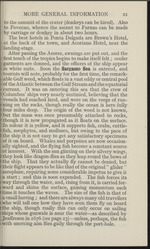 |
“...but owing to the pace of
i the ship it is not easy to get any satisfactory specimens
of it on board. Whales and porpoises are now occasion-
ally sighted, and the flying fish become a constant source
of interest. With the sun glinting on their silvery wings,
(they look like dragon-flies as they leap round the bows of
the ship. That they actually fly cannot be denied, but
their flight appears to be like that of the original “ glider "
«aeroplane, requiring some considerable impetus to give it
a start; and this is soon expended. The fish forces its
|way through the water, and, rising from it, is carried for-
fward and skims the surface, gaining momentum each
kime it touches the waves. The size of the fish is that of
a small herring; and there are always many old travellers
iwho will tell one how they have seen them fly on board
‘the ship, though really this can only occur on sailing
i ships whose gunwale is near the water—as described by
j Jeaffreson in 1676 (see page 23)—unless, perhaps, the...”
|
|
| 2 |
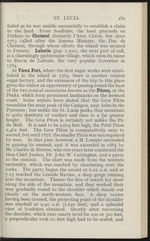 |
“...verdure and rises to a far greater
height. The Gros Piton is certainly not unlike the Pic
du Midi. It is said to be 2,619 feet high, the Petit Piton
2,461 feet. The Gros Piton is comparatively easy to
ascend, but until 1878, the smaller Piton was unconquered
by man. In that year, however, a M. Lompré succeeded
in gaining its summit, and it was ascended in 1885 by
Mr. Charles de Brettes, who two years later conducted the
then Chief Justice, Dr. John W. Carrington, and a party
to the summit. The start was made from the western
extremity, which was reached by clambering over the
rocks. The party began the ascent at 6.22 a.m. and at
7.15 reached the Grande Ravine, a deep gorge running
into the mountain. Thence the line of march lay more
along the side of the mountain, and they worked their
way gradually round to the shoulder which stands out
clearly on the north-western face. A deep ravine
having been crossed, the projecting point of the shoulder
-was reached at 9.40 a.m. (1,640 feet), and a...”
|
|
| 3 |
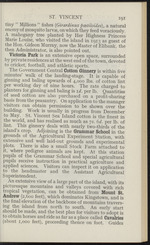 |
“...pupils receive instruction in practical agriculture and
applied sciences. Visitors can inspect it on application
to the headmaster and the Assistant Agricultural
Supérintendent.
An extensive view of a large part of the island, with its
pictm-esque moimtains and valleys covered with rich
tropical vegetation, can be obtained from Mount St.
Andrew (2,600 feet), which dominates Kingstown, and is
the final elevation of the backbone of moimtains travers-
al? fh® island from north to south. An early start
should be made, and the best plan for visitors to adopt is
to obtain horses and ride as far as a place called Cavalries
(about 1,000 feet), proceeding thence on foot. Guides...”
|
|
| 4 |
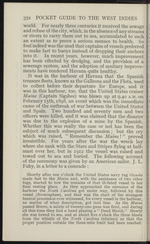 |
“...was raised and
towed out to sea and buried. The following account
of the ceremony was given by an American sailor, J. L.
Fahy, in a letter to a comrade :
Shortly after one o’clock the United States navy tug Osceola
made fast to the Maine and, with the assistance of two other
tugs, started to tow the remains of that ill-fated vessel to her
final resting place. As they approached the entrance of the
harbour the North Carolina got under way, followed by this
vessel (Birmingham), and that was the start of the strangest
funeral procession ever witnessed, for every vessel in the harbour,
no matter of what description, got into line. As the Maine
passed Morro, a salute of twenty-one guns was fired, and during
all this time they had a band playing a “ Dead March.” Slowly
she was towed to sea, and at about five o’clock the three blasts
from the whistle of the North Carolina informed us that the
proper position outside the three-mile limit had been reached....”
|
|
| 5 |
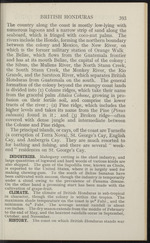 |
“...week-
end ” residences on St. George’s Cay.
INDUSTRIES. Mahogany cutting is the chief industry, and
large quantities of logwood and hard woods of various kinds are
also shipped. The gum of the Sapodilla tree, known as Chicle,
is exported to the United States, where it is largely used for
making chewing-gum. To the south of Belize bananas have
been cultivated with success, though the industry is temporarily
under a cloud owing to the prevalence of Panama disease.
On the other hand a promising start has been made with the
cultivation of grape-fruit.
CLIMATE. The climate of British Honduras is sub-tropical
in character, though the colony is within the tropics. The
maximum shade temperature on the coast is 90° Fahr., and the
minimum 62° Fahr. The average annual rainfall is about
100 inches. The dry season extends from the middle of February
to the end of May, and the heaviest rainfalls occur in September,
October, and November.
HISTORY. The coast on which British Honduras stands was...”
|
|
| 6 |
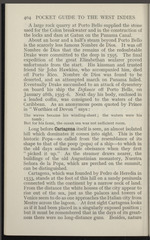 |
“...404 POCKET GUIDE TO THE WEST INDIES
A large rock quarry at Porto Bello supplied the stone
used for the Colon breakwater and in the construction of
the locks and dam at Gatun on the Panama Canal.
About an hour and a half’s steam beyond Porto Bello
is the scarcely less famous Nombre de Dios. It was off
Nombre de Dios that the remains of the redoubtable
Drake were committed to the deep in 1595. The final
expedition of the great Elizabethan seafarer proved
unfortunate from the start. His kinsman and trusted
friend Sir John Hawkins, who accompanied him, died
off Porto Rico. Nombre de Dios was found to be
deserted, and an attempted march on Panama failed.
Eventually Drake succumbed to an attack of dysentery
on board his ship the Defiance off Porto Bello, on
January 28th, 1595-6. Next day his body, enclosed in
a leaded coffin, was consigned to the waters of the
Caribbean. As an anonymous poem quoted by Prince
in “ Worthies of Devon ” says :
The waves became his winding-sheet; the waters were his...”
|
|
| 7 |
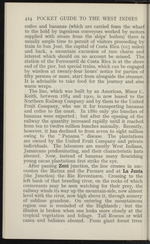 |
“...ingenious conveyors worked by motors
supplied with steam from the ships’ boilers) there is
usually ample time to permit of visitors proceeding by
train to San José, the capital of Costa Rica (103 miles)
and back, a mountain excursion of rare charm and
interest which should on no account be missed. The
station of the Ferrocarril de Costa Rica is at the shore
end of the pier, but special trains, which can be engaged
by wireless at twenty-four hours’ notice for parties of
fifty persons or more, start from alongside the steamer.
It is advisable to take food for the journey and also
warm wraps.
The line, which was built by an American, Minor C.
Keith, between 1884 and 1900, is now leased to the
Northern Railway Company and by them to the United
Fruit Company, who use it for transporting bananas
and coffee to the coast. In 1880 only 360 bunches of
bananas were exported; but after the opening of the
railway the quantity increased rapidly until it reached
from ten to twelve million bunches annually...”
|
|
| 8 |
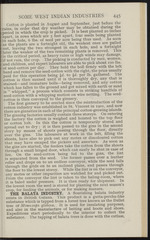 |
“...where
it is baled under pressure. It is then ready for shipment. In
the lowest room the seed is stored for planting the next season s
crop, for feeding the animals, or for making manure.
THE BALATA INDUSTRY. A flourishing balata industry
exists in British Guiana. This product is a gutta-percha-like
substance which is tapped from a forest tree known as the Bullet
tree or Mimusops globosa. It is used for insulating purposes,
and also in the manufacture of belting and boots and shoes.
Expeditions start periodically to the interior to collect the
substance. The tapping of. balata trees is done with the cutlass....”
|
|
| 9 |
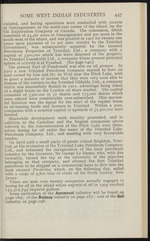 |
“...Company started to bore on
lanH owned by him and Dr. de Wolf near the Pitch Lake, with
.so great a measure of success that they were very soon able to
dispose of the venture to the Trinidad Oilfields, Ltd., a company
which was successfully floated in 1910, advantage being taken
of a slight boom on the London oil share market. The capital
consisted of £300,000 in £1 shares and 175,000 shares which
were offered were considerably over-subscribed. This success-
ful flotation was the signal for the start of the regular boom
in oil-bearing lands and licences in Trinidad. Within a year,
companies with a nominal capital of upwards of £2,500,000 were
•formed. • , .
Meanwhile development work steadily proceeded, and in
addition to the Canadian and the English companies above
referred to, the concessionaires of the Pitch Lake were them-
selves boring for oil under the name of the Trinidad Lake
Petroleum Company, Ltd., and meeting with very favourable
On April 29th a small party of guests visited Brighton...”
|
|
